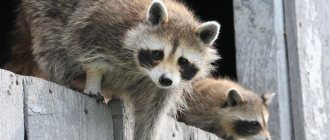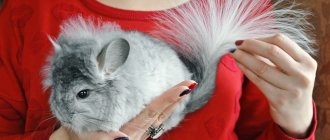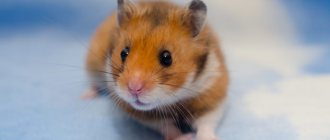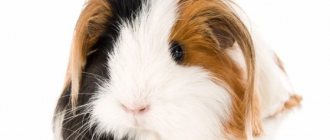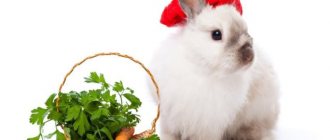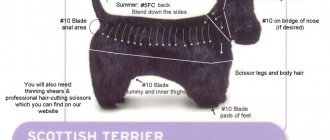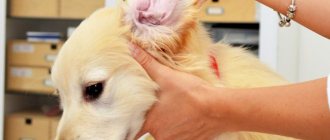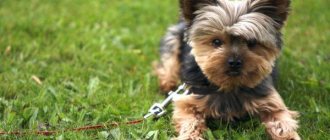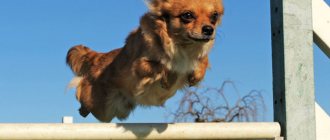Characteristics of a guinea pig: advantages and disadvantages
| How long does a guinea pig live? | On average from 5 to 8 years. There are long-livers who live up to 15 years. But this is very rare. Lifespan depends on housing conditions and nutrition. |
| Is it possible to teach a rodent different tricks? | The ability to train is there, but it is difficult to teach. You can teach simple tricks: spin around your axis, stand on your hind legs to beg for food, etc. |
| What size should a guinea pig cage be? | The animal needs a spacious cage or terrarium. The minimum cage floor size for keeping one individual is 30x60 cm. The larger the territory, the more comfortable the kevi live. |
| What does a guinea pig get sick with? | The most common diseases:
|
| What is the price of the animal? | From 500 to 10 thousand rubles, depending on the breed. The most expensive are the hairless Guinea pigs - Skinny (from $80), Baldwin (from $120). |
| Does pig stink? | With proper care, your pet will not smell. |
| What should you not feed this animal? |
|
| What is the best way to transport caves? | A special plastic container, terrarium or regular carrier for cats or small breed dogs will do. In cold weather, it is necessary to insulate the carrier with a heating pad with warm but not hot water, a layer of hay or an old woolen item. |
| Which drinking bowl and feeder is better to buy? | There should be two feeders - for green food and for dry food. Choose stable bowls, preferably ceramic ones, so that the animal cannot turn them over. Vertical nipple drinkers are very convenient for small rodents. The volume of the drinking bowl is at least 250 ml per individual. It is better to use filtered or special bottled water. It must be changed daily, even if the pet does not have time to drink everything. |
| Which litter to choose for your pet? | The best option is granulated or regular sawdust, poured onto the bottom of the cage in an even layer of 4–6 cm. The filler is replaced weekly. You can buy it at a pet store or make it yourself. Granular filler absorbs better than regular sawdust. |
| Does a rodent need vaccinations? | No, pigs are not vaccinated. They are given prophylaxis against external and internal parasites. |
| How to choose the right guinea pig? | It is necessary to choose a moderately well-fed individual with shiny fur and eyes, with a good appetite, at the age of 4 - 5 weeks. The rodent should not have bald spots, scabs or peeling skin, dirty or matted hair in the anal area, or discharge from the eyes or nose. When the pig is picked up, it should not struggle or squeal. It is better to purchase a pet from a breeder with a good reputation. |
Pros of keeping caves:
- Ideal pets for children, do not take up much space.
- They quickly get used to a nickname or conventional call (whistle).
- Non-aggressive (biting individuals are almost never found).
- Indifferent towards other animals.
- They are unpretentious in food, do not need walks and physical activity.
- They are considered the most hypoallergenic pet.
Difficulties of maintenance and care:
- They are difficult to train, but some tricks can be taught.
- They can be intrusive - they beg for food and affection.
- Noisy - they make many different sounds: whistling, squealing, squeaking, grumbling, grunting (each sound has its own meaning).
- They are very active, so they scatter hay, droppings and sawdust around the cage.
- They chew furniture, wires and other things.
- While walking outside the cage, they may relieve themselves on the carpet or floor.
- They mark their territory with urine and secretions from their glands.
- They are afraid of cold and overheating and catch cold easily.
- They do not tolerate loneliness well, so a companion is required.
- They are shy, so they take a long time to get used to people.
Maintenance and care
Choosing a cage, location and accessories for it
The guinea pig is an unpretentious pet, keeping and caring for which is quite simple. The most convenient size of a wire cage pallet for keeping a pair of guinea pigs at home is 120x60 cm. Sawdust or other filler from a pet store is poured onto the pallet in a layer of 3 - 5 cm. When choosing granulated sawdust, mix them with wood, otherwise the pigs will develop calluses on paws.
The height of the cage should be from 30 to 50 cm, which will give the animals the opportunity to stand on their hind legs. You can stack one cage on top of another to save space. The cage should be placed in a bright place, but without direct sunlight. It is very important to protect animals from drafts. The optimal average daily temperature for keeping a rodent is 18 – 20C˚. In summer, animals can be kept outdoors, for example in a garden, protected from light.
Many people prefer a cage to a closed terrarium. This is due to the fact that the filler flies from the first over a long distance. The terrarium protects well from drafts, but it is more problematic to secure a hammock, salt stones, drinking bowl and other accessories in it. On the other hand, the cage is more breathable, and it is easier to take the animal out for communication. Required accessories for the cage:
- drinking bowl;
- two feeders;
- flat pebble for grinding claws;
- salt stone or mineral salt wheels;
- tree branches;
- hammock, ladders, shelves, manholes (optional).
Pet stores offer houses for rodents made of different materials: bark, wood, plastic. Although, experts do not recommend buying a house for kevi. The pet may become less tame and sociable; it will spend all its free time in solitude.
The cage is cleaned 1-2 times a week. Usually pigs go to the same place to relieve themselves, so you can teach them to relieve themselves in a special tray and change it daily.
Shared content
Guinea pigs feel calm and comfortable only in the company of a fellow partner. This is inherent in them by evolution and is due to the life of caves in the wild. It is easier to keep two or more females in one cage. If you have two boys, they should be provided with enough territory, food and water to avoid quarrels. As a last resort, the animals can be separated by a thin wire partition, through which they will see each other and sniff. Keeping opposite-sex couples should not be practiced in order to avoid uncontrolled reproduction.
Members of the Federal Association of Medical Practitioners (Germany) have proven that 50% of Kevi's behavior comes from social communication with their own kind. In many European countries (Germany, Holland, Austria) it is prohibited to keep social animals alone. This includes the Hawaiian pig.
Walks
If there is enough space in the cage and there is an opportunity to “have fun” (hammock, ladders and other attractions), then walking your pet is not necessary. But if the cage is too small or there is nothing in it except a feeder and water bowl, you can periodically organize walks for the pigs. To avoid such troubles as chewed furniture or damaged carpet, it is better to build a special fenced enclosure. You can let pigs out to run around in the fresh air, but they need to be closely monitored so that they don’t run into some hole or become prey to a larger animal.
Dental care
How you care for your guinea pig's front teeth is very important. They require special attention. Like all rodents, they grow throughout their lives and require constant grinding. Usually the animals themselves grind off the excess on the young branches of fruit trees, but sometimes they need help. The incisors can grow to a length that can pierce the tongue or gums. It also happens that kevi have an incorrect position of their incisors from birth. In this case, you have to contact the veterinarian once every 3-4 months so that he can shorten the overgrown teeth.
Ear care
It is enough to wipe the ears with a clean, dry cloth once every few weeks. If they have a foul odor or discharge, this could be a symptom of an ear parasite. You should consult a doctor as quickly as possible.
Eye care
If discharge or crusts appear in the corners of the eyes, they are carefully removed with a cloth soaked in boiled water. Excessive tearing or redness of the eyelids symbolizes eye disease and requires immediate examination by a specialist.
Nail care
Nails need to be trimmed from the age of 1 year. Do this 1 – 2 times a year. For cutting, use a sharp nail clipper to trim the nails of cats or small breeds of dogs. To avoid injuring your pet, first read on the Internet how the procedure is carried out. You can contact your veterinarian for professional help. A damaged blood vessel passing through a claw takes a very long and painful time to heal. The wound can cause infection and blood poisoning.
Grooming
For short-haired and rosette-haired individuals, it is enough to brush them 1 – 2 times a week. Every time you hold a pig in your hands, a small amount of hair remains from it. This is the norm. Just like the fact that there are small bald patches behind the rodent's ears.
Long-haired breeds are brushed daily. First with a long-tooth comb, then with a soft brush. To make combing easier, you can lightly moisten the fur with water from a spray bottle. Matted wool that cannot be untangled is trimmed with sharp scissors.
Bathing
Animals are bathed only in cases of extreme necessity: if the fur is dirty in the ground, the animal has had diarrhea, etc. A shallow plastic bowl is suitable for bathing. Water is poured into it to a level of 3–4 cm from the bottom. The water temperature should not be higher than 38C˚. The pig is bathed using baby shampoo for little ones or a special veterinary shampoo for rodents. When swimming, protect your ears, eyes and nose from water. The bathed animal should be wiped dry with a warm towel. Long-haired individuals should be dried with a hairdryer using warm, not hot air. A freshly bathed pet is very sensitive to drafts and cold temperatures.
Creating favorable conditions for your pet
Although caring for guinea pigs is quite simple, they need to be provided with good living conditions. The best temperature for keeping rodents is 16−20°C. At the same time, they tolerate heat much worse than cold. But you should also not keep your pets at temperatures below 10°C for a long time.
Another important requirement is air humidity, which should be between 50-60%. If these numbers are lower, it is worth purchasing a humidifier. These rodents are susceptible to colds, so the cage should be placed away from open windows and doorways to avoid drafts.
Guinea pigs are diurnal, so good lighting is important for them to live comfortably. However, it is not recommended to place the cage in direct sunlight.
The animals' diet should be complete, rich in vitamins and minerals. The diet should include vegetables, fruits and grain mixtures; it is best to purchase ready-made food in the form of granules.
Reviews about keeping and caring for guinea pigs are very contradictory. But if you use our advice, the animal will bring only joy.
Feeding
Feeding a pig is one of the most important factors in the harmonious development and good health of a pet. From the wrong menu, kevi quickly get sick and die. Ideally, a rodent's diet consists of the following types of food:
- Hay - 60% - the guinea pig should always have in excess (choose pleasant-smelling and greenish hay, in no case moldy).
- It is not recommended to make a balanced grain mixture from a pet store - 20% - on your own, since many grains are prohibited for cavy.
- Grass – 20% – this also includes fresh vegetables and fruits.
- Salt or mineral salt stone.
- Young twigs - fruit trees or spruce, willow, aspen (in unlimited quantities).
- Homemade crackers, without flavorings or dyes, are given occasionally in small quantities.
In terms of nutrition, the Hawaiian pig is a very delicate creature, therefore, when offering new food to the animal, it is necessary to constantly monitor whether the product has caused digestive upset. What suits one individual may cause diarrhea or allergies in another.
Important feeding rules:
- Rodents' drinking bowl should always be filled with fresh water with vitamin C dissolved in it (the required dosage should be checked with a veterinarian in accordance with the weight and number of individuals in the cage).
- There should always be hay in the cage, even in summer, when there is a lot of fresh greenery.
- Guinea pigs are fed twice a day, large breeds - three times.
- The serving size for feeding one pig is 1 – 2 tablespoons of food.
- Cereal sticks with honey, popular in pet stores, can be given as a treat no more than 2 times a week.
- Many herbs are deadly for rodents, so you can only give 5 - 10 names that you are sure of.
Some poisonous herbs:
- Parsnip.
- Lilac.
- Bindweed.
- Iris.
- Oak.
- Chestnut.
- Ambrosia.
- Buttercup.
- Hawthorn.
- Lily of the valley.
- Laurel.
- Burdock.
- Spinach.
- Sorrel.
- Dandelion flowers and stems (leaves and roots can be given).
- Scillas.
- Poppy.
Herbs allowed for cavy:
- Anise.
- Pansies.
- Plantain.
- Dandelion leaves and roots.
- Melissa.
- Lettuce.
- Peppermint.
- Chamomile.
- Linden.
- Calendula.
- Clover (with caution, there may be bloating).
- Strawberries.
- Cowberry.
- Coriander.
- Yarrow.
- Caraway.
- Rose hip.
- Blueberry.
- Alfalfa.
- Wheatgrass.
- Sedge.
Origin story
These animals were made tame back in the 5th millennium BC by representatives of the tribes of South America. The ancestors of modern inhabitants of the south of Colombia, Peru, Ecuador and Bolivia at one time consumed these mammals as food. According to scientists, wild guinea pigs wanted to be close to humans without any coercion. The Incas used guinea pigs as sacrificial animals, so they were constantly sacrificed to the sun god. Animals that had a variegated brown or pure white color were very popular. It is generally accepted that modern guinea pigs descended from their ancestors "Cavia aperea tschudi", which can be found in mountainous areas.
Interesting to know! Such mammals form small groups and live in very spacious underground burrows. Animals living in the mountains of Chile have significant differences in appearance when compared with domestic guinea pigs. This is due to their food supply, which is poor in water but rich in cellulose compounds.
Reproduction
Preparing for pregnancy
Despite the fact that the animals reach sexual maturity early, experts recommend breeding them at the age of at least 10 months. When choosing a pair, give preference to individuals of the same breed and age category. Future parents should not be related. Obese individuals should also be excluded. A week before the expected mating, increase the amount of vitamin E in the animals’ diet.
It is advisable to plan a future pregnancy so that fertilization takes place no later than November, then the female will have time to feed her offspring before the spring molt. Otherwise, the combination of lactation and molting can be disastrous for the female, weakened after pregnancy. For the same reason, it is not recommended to cover females more than three times, and rare breeds that are difficult to care for and breed, twice a year.
Estrus in guinea pigs lasts 2 days and repeats every 12 to 20 days. The most favorable period for fertilization is the first 12 hours. It is not difficult to notice the pig’s readiness to become a mother; she takes a characteristic pose: she raises her back, spreading her legs and standing motionless. Males are almost always ready to mate.
The fertilized guinea pig is placed in a separate cage. If the next heat does not occur, then this indicates pregnancy, which will last about 10 weeks. Multiple pregnancies may result in earlier births.
Toxicosis in guinea pigs
So-called toxicosis can become a big problem during pregnancy. This is a painful condition that is typical for many individuals in the last weeks of pregnancy or the first days after childbirth. Often this condition leads to the death of the animal. Manifestations of toxicosis:
- Muscle cramps.
- Loss of appetite or complete refusal to eat.
- Profuse drooling.
- Tousled, dull fur.
The causes of toxicosis are poor nutrition, lack of water or vitamins, stress or multiple pregnancy. It is necessary to isolate the pregnant female from all these factors and provide her with special care.
Caring for a pregnant female
- Calm walks 1 – 2 times a day.
- Stable temperature and humidity in the room.
- Keep in a cage with an area of at least 1200 – 1500 cm2.
- No stress - it is not recommended to handle the pig (it can cause miscarriage), pet it, or clean the cage often or for a long time.
- A varied diet - in the first half of pregnancy, the feed rate is increased by 1/3, in the second half - by 2 times.
- In addition to drinking water, they offer rosehip infusion, milk and tomato juice.
- Mineral and vitamin supplements in food (according to the recommendation and dosage of a veterinarian).
- Installation of a house in a cage with a nest made of fresh hay.
- For hygiene purposes, long-haired females need to be trimmed a few days before giving birth.
Childbirth and baby care
Childbirth is usually quick and uneventful, lasting no more than 30 minutes. Newborns are born sighted, hearing and with developed incisors. Weight ranges from 50 to 140 g. A litter contains on average 3 – 5 individuals. The cubs grow quickly, and on the 2nd - 3rd day they begin to eat food familiar to adults. By one month they become full-fledged guinea pigs, which can be separated from their mother.
It may happen that the mother dies during childbirth or after it from toxicosis. Then the best option would be to place the offspring with another female, since it is better for the babies to be among relatives. It is usually possible to feed orphans with diluted dry cream from a pipette. Be sure to provide the little ones with access to eat the droppings of adult pets. If by the 17th – 20th day of life the weight of the cubs has doubled, then we can assume that they are saved and are developing normally.
Unfortunately, non-viable babies born weighing up to 40 grams must be disposed of immediately. It is almost impossible to get out of them and, even if possible, the individuals will be too weak and sickly to live a full life.
Owner reviews
Naturally, high-end guinea pigs are inaccessible to ordinary buyers. In any case, if you plan to breed them, you should opt for purebred specimens.
Interesting to know! In our country, guinea pig breeding has not yet reached such a high level as abroad. Despite this, true connoisseurs of these animals try to acquire individuals that have an attractive and exotic appearance.
It should also be remembered that you cannot cross long-haired and short-haired representatives of the breeds, since the result will be offspring that are low-quality mestizos and no one will allow them to be shown at exhibitions. On top of that, crossing different breeds is also unacceptable because it hinders the improvement of the breed data of any of the species.
Guinea pigs have earned the right to be considered one of the most sought-after pets. Ease of care and maintenance is acceptable for everyone, even novice owners. This is an affectionate and sociable animal that is perfect for families with children.
What does a guinea pig get sick with?
- Parasites – internal (worms) and external (fleas, ticks).
- Alopecia (hair loss) is caused by poor diet, stress, lack of vitamins, and the presence of parasites.
- Wounds and fractures - occur when the conditions for keeping rodents are violated.
- Rickets is a disease characteristic of animals suffering from a lack of sunlight and vitamins.
- Colds (acute respiratory infections, pneumonia, otitis, cystitis) are caused by hypothermia of the animal.
- Abnormalities of the incisors - occur at the genetic level or due to improper care of the pet's teeth.
- Disturbances in the functioning of the digestive system (diarrhea, constipation, enteritis, flatulence) arise due to non-compliance with feeding rules, as well as due to infections.
- Eye diseases (keratitis, conjunctivitis) – causes: infection, chemical and mechanical irritants.
- Obesity is caused by unbalanced or excess nutrition.
Plague
It is a contagious, fatal viral disease. There is no cure, so the animal will have to be euthanized. Symptoms: weakness, apathy, convulsions, impaired coordination of movements, paralysis.
Pseudotuberculosis
This is a common bacterial disease in the mumps family that leads to paralysis of the limbs. A sick animal should be isolated and immediately taken to a veterinarian. Symptoms: diarrhea, refusal to feed, exhaustion.
Lymphocytic choriomeningitis
This is a contagious, incurable disease that can be transmitted to humans. Symptoms: difficulty breathing, convulsions, pleurisy, increased body temperature.
Attention! The normal body temperature of a guinea pig is 37 – 39.5 C˚.
Parafit
The causative agent is a microbe of the genus Salmonella, which causes intestinal infections. Symptoms: diarrhea, lethargy, apathy, refusal to feed.
Pasteurellosis
This is a dangerous incurable disease, the affected individual should be destroyed. The causative agent is a gram-negative, non-motile ovoid rod. Symptoms: purulent runny nose, sneezing, ulcers on the skin, wheezing, diarrhea, convulsions.
Signs of a sick animal:
- Apathetic and lethargic behavior.
- The pet’s desire to retire, to hide in a corner of a cage or house.
- Dull and disheveled fur.
- Discharge from the eyes or nose.
- Soiled or wet fur in the anal area.
